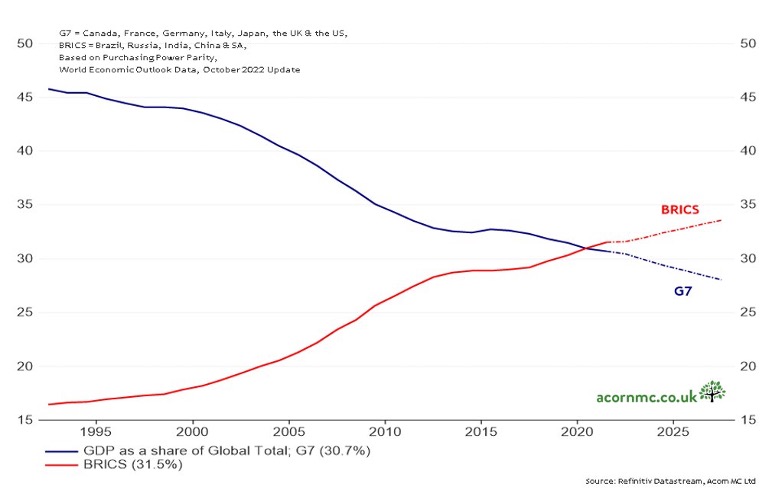Challenging the Dollar’s Dominance: BRICS and Pathways of De-Dollarization

Illustration from FPCI UI.
The global economy is undergoing significant changes due to the emergence of a new power center—the BRICS, consisting of Brazil, Russia, India, China, and South Africa. They intend to reduce reliance on the United States dollar (USD) and sanctions and are pursuing an economic revolution through “de-dollarization”. One could say that the idea of de-dollarization is far from the first, with notable discussions among oil-producing countries during the 1970s oil crisis and calls for diversification away from the dollar following the 2008 global financial crisis. However, the recent initiative by BRICS to pursue de-dollarization has taken on a new level of significance, given that the sheer size and influence of BRICS made this initiative a serious issue.
Some may argue that BRICS’ sudden implementation to de-dollarize trade is a reaction to America’s unprecedented sanctions against Russia, one of its members (First Post, 2023). However, in essence, such acts instead reveal the urgency of pursuing de-dollarization. As a result, BRICS must prioritize the de-dollarization agenda and actively work towards establishing a polycentric global monetary system by promoting the internationalization of the currencies of its member nations. In light of this, what specific strategies and steps could BRICS adopt to effectively and successfully implement de-dollarization in the near future?
BRICS and the Serious Prospect of De-Dollarization
The BRICS countries could potentially become successful leaders in pushing this agenda, backed by their increasing significant GDP contribution. For instance, China’s GDP growth rate averaged 8.6% per year, India’s was 5.9%, and Russia, Brazil, and South Africa ranged from 1.8% to 2.7% (Alekseev, 2021). Thus, with 42% of the world’s population, the BRICS countries contribute 31.5% to the world’s GDP and are expected to contribute more than 50% by 2030 (TV BRICS, 2023). With their influence, which is likely to persist and even grow even more in the future, BRICS countries can be expected to implement de-dollarization successfully.

Although the BRICS union is unquestionably advantageous for its members, its collective status as the largest developing economies that manage to overtake G7—by making up a larger share of global GDP in Purchasing Power Parity (PPP) terms—should not be overstated. Most members see the bloc as a way to exchange ideas and adopt a common stance on issues of shared interest (Movchan, 2015). Rising corporate and public debt in the US since 2012, which respectively amounted to 78.3% and 101.6% of GDP by the first quarter of 2020, poses a significant risk to the stability of other countries’ economies, especially emerging markets that heavily rely on the USD for foreign trade and domestic financial transactions (Alekseev, 2021).
Energy products, raw materials, bulk commodities, and military hardwares bilateral trade among BRICS countries is thriving from 2020-2023 (Fernandes, 2023). This demonstrates BRICS’ ability to improve members’ economic growth and power globally. Evidently, not having US sanctions restraining them would enhance intra-BRICS trade by means of removing trade barriers, reducing tariffs, and increasing investment in each other’s countries. Thus, booming economic growth may place BRICS countries as a viable destination for global investments (Chatterjee & Naka, 2022). Altogether, positive and sustainable economic ties could be developed, further improving collective economic growth.
A further indication of booming trade in de-dollarization is shown through BRICS countries’ national currencies which have progressively gained more market share in the dollar-based global currency system despite holding comparatively less significance than the USD itself (Liu & Papa, 2022). One way to gain more market share in the dollar-based global currency system is by using national currencies for cross-border trade transactions. For example, China used the Chinese Yuan to trade with Russia after its invasion of Ukraine. Usage of the Chinese Yuan now has surpassed USD and thus making it the most traded currency in Russia (Liu & Papa, 2022). Another milestone that attest to this is when China managed to reach an agreement with Saudi Arabia to trade oil using Yuan, or what is known as the Petro-Yuan (Shekhar, 2023). These examples can be seen as a form of currency diversification. Now that one of the largest oil exporting countries has pursued an “alternative path” away from the dollar, it could overhaul old practices and could significantly impact the future of international oil trade.
The Bumpy Path to De-Dollarization: Differing Dynamics Among BRICS Countries, the US, and the Dollar
Even if BRICS’ de-dollarization ambitions seem promising, it is predicted that the countries involved will experience various obstacles in the future. For instance, India’s relationship with the US is closer than its ties to fellow BRICS member, China. The long-term bilateral cooperation between India and the US may prevent India from adopting a cohesive de-dollarization strategy in the short run, as they are more dependent economically on the US compared to China (Liu & Papa, 2022). Thus, despite ongoing border tensions with China, India’s acceptance of economic alignment with China remains uncertain (First Post, 2023). Additionally, economic inequality among BRICS countries might cause disproportionate dominance where only the most influential countries play a significant role in the de-dollarization agenda.
Furthermore, the varying relationships of each BRICS countries with the US combined with differing vulnerabilities to US sanctions add complexity to the situation. Some countries may be less entrenched in the USD system or less vulnerable to US sanctions, if not both, making them not widely affected if they chose to implement de-dollarization. On the contrary, countries like India, as mentioned before, are more integrated into the USD system to sustain their foreign economic trade. Consequently, regardless of the aspirations for alternatives to the USD’s supremacy, its depreciation could negatively impact the value of their considerable dollar-denominated assets (Liu & Papa, 2022). Therefore, BRICS members must carefully weigh their ambitions to balance their desire with the most favorable conditions. Nonetheless, while not every BRICS country intends to overtly contest USD supremacy, they collectively share a desire to reduce their reliance on it.
Measuring BRICS’ Chance of Success in Establishing Its Ambition
Taking everything into consideration, it’s safe to say that the chances of successful de-dollarization are hard to come by in the foreseeable future. First of all, it is crucial to note that the contribution of the economic growth in BRICS is highly dominated by China, whose accumulated GDP percentage is more than double that other BRICS countries combined GDP (Bishop, 2022). The GDP per capita for each BRICS country between 2008-2021 shows imbalances: China’s GDP per capita rose 138%, while this figure stands at 85% for India, 13% for Russia, 4 % for Brazil, and 5% contraction in the same period for South Africa (McNamara, 2023).
De-dollarization would be difficult to achieve due to persisting imbalances of BRICS countries’ respective economic performance. BRICS needs to adjust and collaborate effectively to balance its members’ economic power before further advancing their ambition for de-dollarization. Otherwise, the bloc would become ‘China carrying BRICS,’ not ‘BRICS’ as a bloc which indicates a possibility for the BRICS to establish Yuan as their currency (Reuters, 2016). Nevertheless, the chances of this actually happening are slim, due to the fact that concerned countries have proposed establishing a “BRICS currency” (Sullivan, 2023).
Indonesia’s Interest in De-dollarization to Join “BRICS Plus”
Viewing the de-dollarization enormous benefits, it is no wonder that Indonesia has expressed interest in joining the BRICS format (Ellis, 2022). The “BRICS Plus” could then be established as a forum for additional developing countries joining the BRICS (Dinic, 2022). Even though the discourse about Indonesia joining ‘BRICS Plus’ is a mere proposal, the scheme still holds a stimulating effect as Indonesia can strengthen multilateral relations with other BRICS countries by joining the group. Indonesia needs China the most, which means that joining BRICS could secure its economy regarding infrastructure improvement (Eng, 2017). Considering the discourse about Indonesia joining BRICS, it indicated that Indonesia also has intentions to pursue its own de-dollarization process, just like BRICS.
Indonesia’s attempt at de-dollarization could be seen from its continuous self-effort with the Central Bank of South Korea by using local currency for trade transaction settlement and investment (Yogatama, 2023). Bank Indonesia (BI) and Bank of Korea Governors signed a Memorandum of Understanding (MoU) to reduce the dependence on USD on 2 May 2023 (Independent Observer, 2023). Realistically speaking, the expansion of BRICS has been in the talk, but no significant developments have happened since 2010. Therefore, the possibility of making ‘BRICS Plus’ is uncertain unless there is clarity from its present members.
To conclude, judging from the bloc’s influence, it is likely for the BRICS countries to persist and emerge in the future which indicates a successful possibility in internationalizing their currencies. In that way, US dominance on trade barriers, tariffs, sanctions, and investment could be minimized together with the currency diversification as the initiation to break the old tradition. However, there is a possibility for the encountered challenge such as the unfavorable political dynamics between the concerning countries in hindering the de-dollarization effort. Indonesia’s practice in de-dollarization could be viewed from its interest in joining ‘BRICS Plus’ together with the effort in establishing the pact with South Korea in reducing the dependence on USD. The de-dollarization attempts by BRICS have been made in an apparent effort despite questioning the time needed for it to be fruitful.
References
Alekseev, B. (2021, April 25). Internationalization of the Currencies of BRICS Countries – PMC. NCBI. Retrieved April 21, 2023, from https://www.ncbi.nlm.nih.gov/pmc/articles/PMC8071586/#CR2.
BRICS India. (2021). Evolution of BRICS. https://brics2021.gov.in/about-brics.
Bishop, M. (2022, October 20). The BRICS Countries: Where Next and What Impact on The Global Economy? Economics Observatory. Retrieved April 18, 2023, from https://www.economicsobservatory.com/the-brics-countries-where-next-and-what-impact-on-the-global-economy.
Chatterjee, M., & Naka, I. (2022, 23 March). Twenty years of BRICS: Political and economic transformations through the lens of land. Oxford Development Studies, 50:1, 2-13, https://doi.org/10.1080/13600818.2022.2033191.
Devonshire, C. (2023, March 27). The BRICS Has Overtaken The G7 In Global GDP. Silk Road Briefing. Retrieved May 7, 2023, from https://www.silkroadbriefing.com/news/2023/03/27/the-brics-has-overtaken-the-g7-in-global-gdp/
Diwakara, A. (2021, December 7). BRICS 20 Years On A Success or Failure? TRT World. Retrieved April 18, 2023, from https://www.trtworld.com/magazine/brics-20-years-on-a-success-or-failure-52410.
Ellis, C. D. (2022, October 23). Indonesia, Hosting The G20 Next Month, Is Also Eying BRICS Membership. Silk Road Briefing. Retrieved April 19, 2023, from https://www.silkroadbriefing.com/news/2022/10/23/indonesia-hosting-the-g20-next-month-is-also-eying-brics-membership/.
Eng, P. van der. (2017, September 4). Jokowi Between Brics and a Hard Place: The Jakarta Post Columnist. The Straits Times. Retrieved April 19, 2023, from https://www.straitstimes.com/asia/se-asia/jokowi-between-brics-and-a-hard-place-the-jakarta-post-columnist.
Fernandes, M. (2023, April 13). BRICS gains new chance to improve global development. Asia Times. https://asiatimes.com/2023/04/brics-gains-new-chance-to-improve-global-development/.
First Post Explainers. (2023, April 4). Ditching the Dollar: Will a new BRICS currency replace the US dollar for trade? Firstpost. https://www.firstpost.com/explainers/dumping-the-dollar-brics-currency-us-dollar-trade-india-china-russia-12403612.html
Gautam, V. (2023, April 4). Explained: Why BRICS Nations Want To Create A New Currency For Trade Payments. IndiaTimes. https://www.indiatimes.com/worth/news/india-working-with-other-brics-nations-on-new-currency-598088.html.
Liu, Z., & Papa, M. (2022, 24 February). Can BRICS De-dollarize the Global Financial System? in Cambridge Elements: Economics of Emerging Markets. Cambridge: Cambridge University Press. https://doi.org/10.1017/9781009029544.
McNamara, P. (2023, February 10). Why a Brics Currency Is a Flawed Idea. Financial Times. Retrieved April 19, 2023, from https://www.ft.com/content/02d6ab99-ea36-41c4-9ad3-9658bb1894a7.
Movchan, A. (2015, July 8). 5 factors limiting the impact of the BRICS nations | World Economic Forum. The World Economic Forum. Retrieved April 24, 2023, from https://www.weforum.org/agenda/2015/07/5-factors-limiting-the-impact-of-the-brics-nations/.
O’Neill, J. (2009, June 19). For Mr. BRIC, nations meeting a milestone (B. Kowitt, Interviewer) [Interview]. In CNN Money. https://money.cnn.com/2009/06/17/news/economy/goldman_sachs_jim_oneill_interview.fortune/index.htm.
Raghavan, S. (2023, April 4). Led by China, India, the 5 BRICS nations now contribute more to world GDP than industrialised G7. ThePrint. Retrieved May 12, 2023, from https://theprint.in/economy/led-by-china-india-the-5-brics-nations-now-contribute-more-to-world-gdp-than-industrialised-g7/1490881/
Reuters. (2016, June 13). BRICS bank to issue yuan, local currency bonds. Reuters. Retrieved 28 April 2023, from https://www.reuters.com/article/china-debt-brics-idAFL4N1952CU.
Saraswat, A. (2023, April 11). BRICS and Dollar. Indian Defence Review. http://www.indiandefencereview.com/spotlights/brics-and-dollar/.
Shekhar, V. (2023, March 30). Petro-Yuan Or Petro-BRICS: The Need For Better Alternative Reserve Currencies To Break Dollar Dominance. Forbes India. https://www.forbesindia.com/article/bharatiya-vidya-bhavan039s-spjimr/petroyuan-or-petrobrics-the-need-for-better-alternative-reserve-currencies-to-break-dollar-dominance/84063/1.
Bimo Bagaskara Indiputera, Debby Aurora Tionardy, and Michelle Calista are staffs of Research and Analysis Division FPCI Chapter UI Board of 2023. They can be found on Instagram with username @bbimobagas @dbyy_aurora @michelleclst





